ENMM29025: Stormwater Treatment Efficacy of Sugar Cane Bales Review
VerifiedAdded on 2023/06/12
|24
|8158
|360
Literature Review
AI Summary
This literature review examines the efficacy of using sugar cane bales for stormwater treatment, focusing on reducing nonpoint-source pollution from herbicides in sugarcane fields. The review assesses urban stormwater management needs, emphasizing on-site infiltration and decontamination through Sustainable Urban Drainage Systems (SUDS). It covers various treatment methods, including 'dim' arrangements like pervious hard surfaces and 'green' arrangements such as biofiltration and bioretention systems. The review also explores the hydrological catchment cycle, the impact of vegetation on pollutant removal, and the structure and function of bioretention systems. It identifies a research gap concerning bioretention and appropriate plant species for the Finnish climate. The study further discusses the use of modeling tools for stormwater management and various lab and field testing techniques for performance assessment. The research aims to enhance the practical applicability of reactive transport modeling for stormwater management needs.
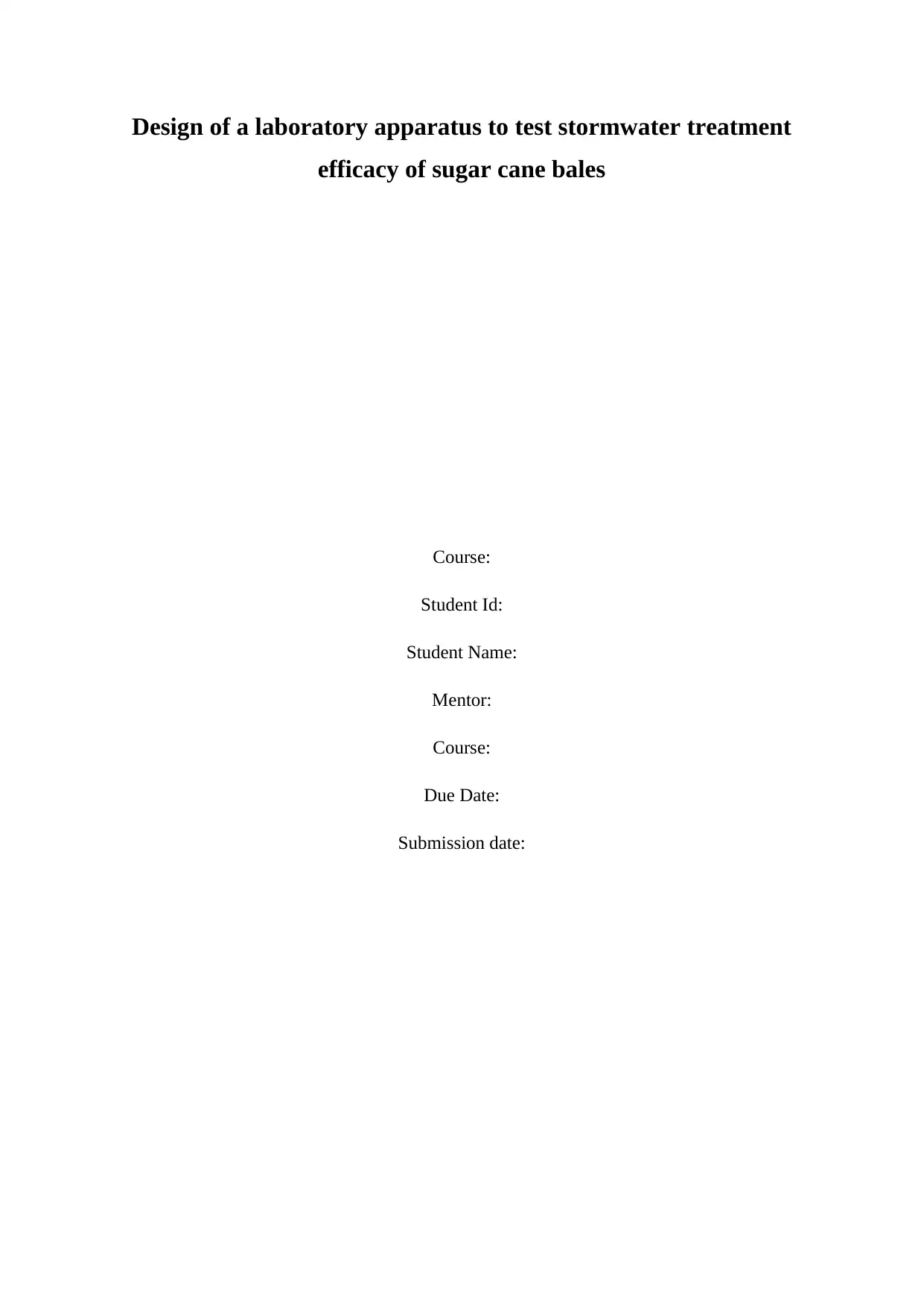
Design of a laboratory apparatus to test stormwater treatment
efficacy of sugar cane bales
Course:
Student Id:
Student Name:
Mentor:
Course:
Due Date:
Submission date:
efficacy of sugar cane bales
Course:
Student Id:
Student Name:
Mentor:
Course:
Due Date:
Submission date:
Paraphrase This Document
Need a fresh take? Get an instant paraphrase of this document with our AI Paraphraser

Abstract
The general targets of urban stormwater administration are seepage and decrease of urban
flooding and additionally security of groundwater and surface waters. As the spill over
streams over to arrive or impenetrable surfaces, it amasses flotsam and jetsam, chemicals, silt
or different contaminations that could unfavourably influence water quality if the overflow is
released untreated. Sullied urban spill over can be a noteworthy wellspring of water
contamination. A cleaned stormwater can likewise be a asset in urban regions.
In this report urban requirements and potential for stormwater contamination control are first
assessed. Penetration and decontamination of the stormwater on location is of essential
significance. The position and plan of appropriate Sustainable Urban Drainage Systems
(SUDS), i.e. a grouping of administration practices and control structures intended to deplete
surface water in a more practical mold than some traditional systems, require cautious
thought to guarantee that they frame a proper and incorporated piece of the scene.
Furthermore, the contaminants in overflow waters should be known before appropriate
treatment techniques can be picked. In Finland, the evaluation of the required stormwater
treatment is regularly willful and based on neighborhood thought. Thought of all the general
needs, managing and controls are too required. This is despite the way that there are no
selective ecological directions for stormwater in Finland. Other natural grants may at present
have commitments concerning stormwater, particularly in groundwater zones. More
connections amongst investigate and commonsense rules are required. Finnish stormwater
quality criteria would be expected to help the specialists and authorities to evaluate the
quality and the need for stormwater cleaning. An imperative reason for this writing diagram
was to discover great practices for upgraded stormwater administration and quality for
Finnish urban territories, in view of the ebb and flow condition of research and practices.
This data is both concerning 'dim' and 'green' arrangements. 'Dark' arrangements incorporate
pervious hard surfaces, with base and sub base for stormwater detainment and treatment, and
particularly included built filtration frameworks. 'Green' arrangements are biofiltration and
bioretention frameworks or rain gardens, i.e. rehearses with the utilization of vegetation, are
looked into. Audit on the hydrological catchment cycle in the urban condition, and related
stormfilters in urban setting, is additionally displayed.
The impact of vegetation for poison evacuation, and biofilter structure concerning vegetation,
is additionally displayed. Using vegetation together with designed soil media is turning into
The general targets of urban stormwater administration are seepage and decrease of urban
flooding and additionally security of groundwater and surface waters. As the spill over
streams over to arrive or impenetrable surfaces, it amasses flotsam and jetsam, chemicals, silt
or different contaminations that could unfavourably influence water quality if the overflow is
released untreated. Sullied urban spill over can be a noteworthy wellspring of water
contamination. A cleaned stormwater can likewise be a asset in urban regions.
In this report urban requirements and potential for stormwater contamination control are first
assessed. Penetration and decontamination of the stormwater on location is of essential
significance. The position and plan of appropriate Sustainable Urban Drainage Systems
(SUDS), i.e. a grouping of administration practices and control structures intended to deplete
surface water in a more practical mold than some traditional systems, require cautious
thought to guarantee that they frame a proper and incorporated piece of the scene.
Furthermore, the contaminants in overflow waters should be known before appropriate
treatment techniques can be picked. In Finland, the evaluation of the required stormwater
treatment is regularly willful and based on neighborhood thought. Thought of all the general
needs, managing and controls are too required. This is despite the way that there are no
selective ecological directions for stormwater in Finland. Other natural grants may at present
have commitments concerning stormwater, particularly in groundwater zones. More
connections amongst investigate and commonsense rules are required. Finnish stormwater
quality criteria would be expected to help the specialists and authorities to evaluate the
quality and the need for stormwater cleaning. An imperative reason for this writing diagram
was to discover great practices for upgraded stormwater administration and quality for
Finnish urban territories, in view of the ebb and flow condition of research and practices.
This data is both concerning 'dim' and 'green' arrangements. 'Dark' arrangements incorporate
pervious hard surfaces, with base and sub base for stormwater detainment and treatment, and
particularly included built filtration frameworks. 'Green' arrangements are biofiltration and
bioretention frameworks or rain gardens, i.e. rehearses with the utilization of vegetation, are
looked into. Audit on the hydrological catchment cycle in the urban condition, and related
stormfilters in urban setting, is additionally displayed.
The impact of vegetation for poison evacuation, and biofilter structure concerning vegetation,
is additionally displayed. Using vegetation together with designed soil media is turning into
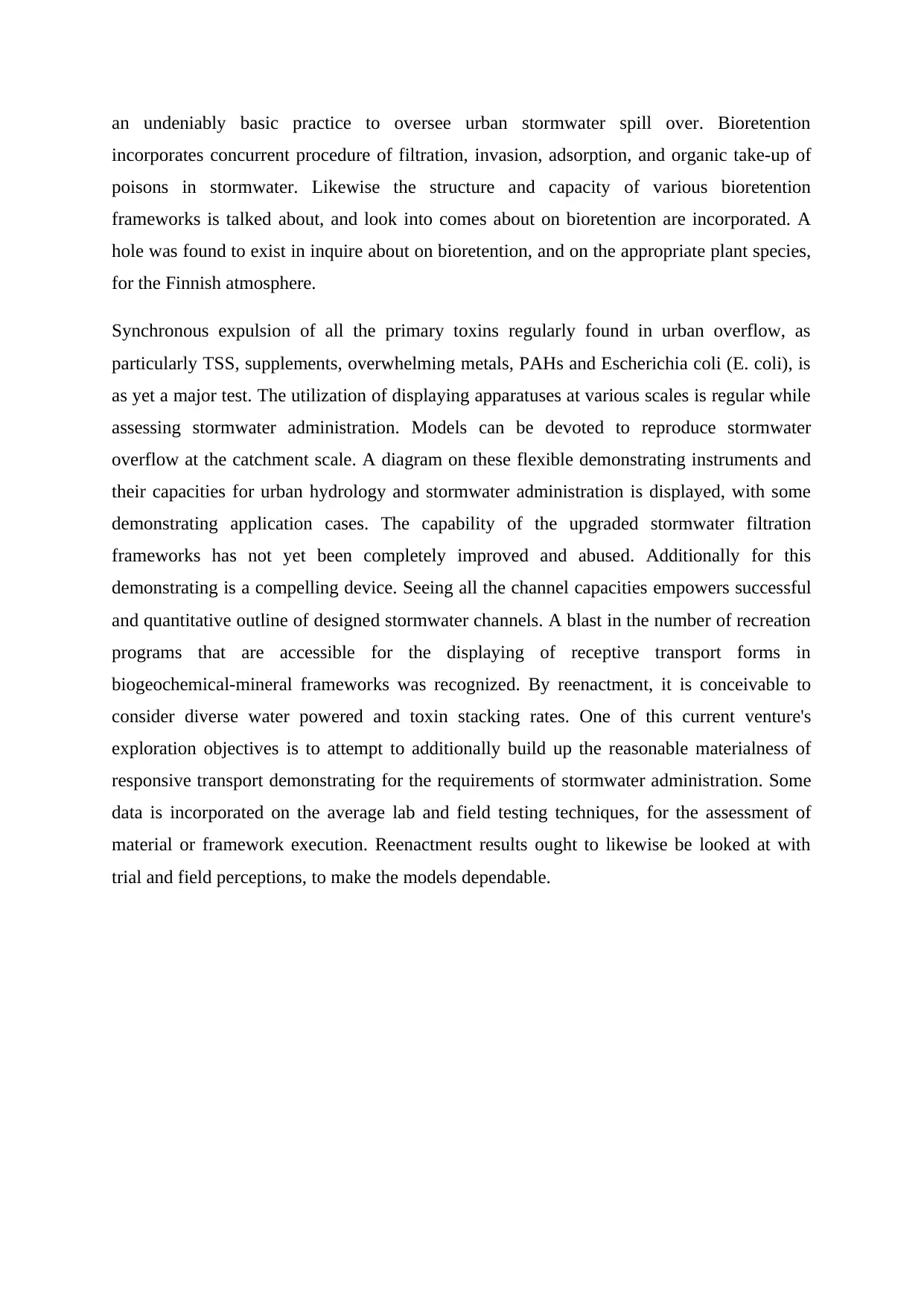
an undeniably basic practice to oversee urban stormwater spill over. Bioretention
incorporates concurrent procedure of filtration, invasion, adsorption, and organic take-up of
poisons in stormwater. Likewise the structure and capacity of various bioretention
frameworks is talked about, and look into comes about on bioretention are incorporated. A
hole was found to exist in inquire about on bioretention, and on the appropriate plant species,
for the Finnish atmosphere.
Synchronous expulsion of all the primary toxins regularly found in urban overflow, as
particularly TSS, supplements, overwhelming metals, PAHs and Escherichia coli (E. coli), is
as yet a major test. The utilization of displaying apparatuses at various scales is regular while
assessing stormwater administration. Models can be devoted to reproduce stormwater
overflow at the catchment scale. A diagram on these flexible demonstrating instruments and
their capacities for urban hydrology and stormwater administration is displayed, with some
demonstrating application cases. The capability of the upgraded stormwater filtration
frameworks has not yet been completely improved and abused. Additionally for this
demonstrating is a compelling device. Seeing all the channel capacities empowers successful
and quantitative outline of designed stormwater channels. A blast in the number of recreation
programs that are accessible for the displaying of receptive transport forms in
biogeochemical-mineral frameworks was recognized. By reenactment, it is conceivable to
consider diverse water powered and toxin stacking rates. One of this current venture's
exploration objectives is to attempt to additionally build up the reasonable materialness of
responsive transport demonstrating for the requirements of stormwater administration. Some
data is incorporated on the average lab and field testing techniques, for the assessment of
material or framework execution. Reenactment results ought to likewise be looked at with
trial and field perceptions, to make the models dependable.
incorporates concurrent procedure of filtration, invasion, adsorption, and organic take-up of
poisons in stormwater. Likewise the structure and capacity of various bioretention
frameworks is talked about, and look into comes about on bioretention are incorporated. A
hole was found to exist in inquire about on bioretention, and on the appropriate plant species,
for the Finnish atmosphere.
Synchronous expulsion of all the primary toxins regularly found in urban overflow, as
particularly TSS, supplements, overwhelming metals, PAHs and Escherichia coli (E. coli), is
as yet a major test. The utilization of displaying apparatuses at various scales is regular while
assessing stormwater administration. Models can be devoted to reproduce stormwater
overflow at the catchment scale. A diagram on these flexible demonstrating instruments and
their capacities for urban hydrology and stormwater administration is displayed, with some
demonstrating application cases. The capability of the upgraded stormwater filtration
frameworks has not yet been completely improved and abused. Additionally for this
demonstrating is a compelling device. Seeing all the channel capacities empowers successful
and quantitative outline of designed stormwater channels. A blast in the number of recreation
programs that are accessible for the displaying of receptive transport forms in
biogeochemical-mineral frameworks was recognized. By reenactment, it is conceivable to
consider diverse water powered and toxin stacking rates. One of this current venture's
exploration objectives is to attempt to additionally build up the reasonable materialness of
responsive transport demonstrating for the requirements of stormwater administration. Some
data is incorporated on the average lab and field testing techniques, for the assessment of
material or framework execution. Reenactment results ought to likewise be looked at with
trial and field perceptions, to make the models dependable.
⊘ This is a preview!⊘
Do you want full access?
Subscribe today to unlock all pages.

Trusted by 1+ million students worldwide
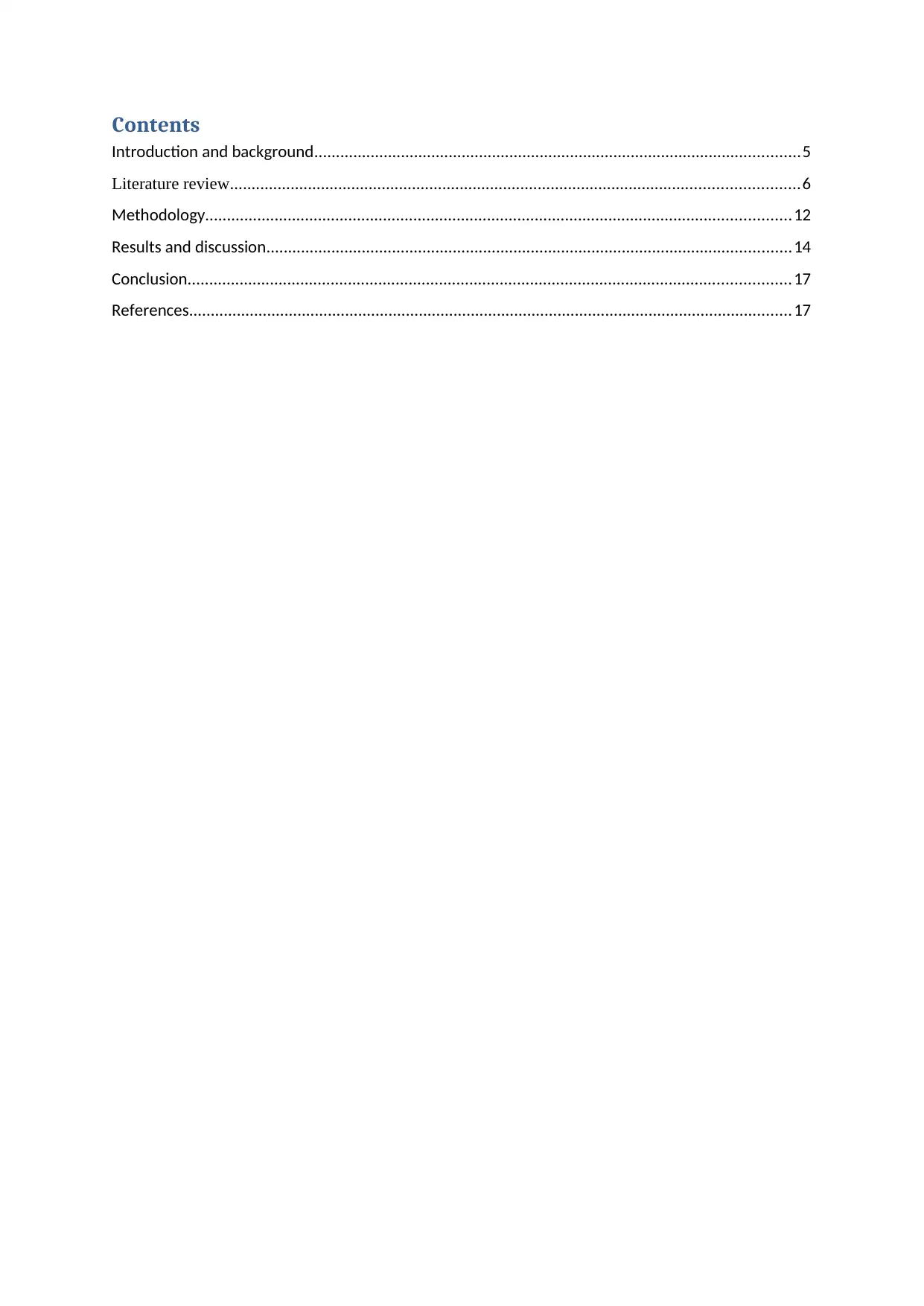
Contents
Introduction and background................................................................................................................5
Literature review...................................................................................................................................6
Methodology.......................................................................................................................................12
Results and discussion.........................................................................................................................14
Conclusion...........................................................................................................................................17
References...........................................................................................................................................17
Introduction and background................................................................................................................5
Literature review...................................................................................................................................6
Methodology.......................................................................................................................................12
Results and discussion.........................................................................................................................14
Conclusion...........................................................................................................................................17
References...........................................................................................................................................17
Paraphrase This Document
Need a fresh take? Get an instant paraphrase of this document with our AI Paraphraser

Introduction and background
Diminishing surface and subsurface misfortunes of herbicides in the dirt and subsequently
their potential defilement of water assets is a national concern. This examination assessed the
viability of sugarcane deposit in decreasing nonpoint-source pollution of connected
herbicides from sugarcane fields. In particular, the impact of mulch deposit on herbicide
maintenance was measured. Two primary medicines were researched: a no-till treatment and
a no-mulch treatment. The measures of extractable atrazine [2-chloro-4-(isopropylamino)- 6-
ethylamino-s-triazine], metribuzin [4-amino-6-(1,1-dimethylethyl)- 3-(methylthio)- 1,2,4-
triazin-5(4H)- one], and pendimethalin [N-(ethylpropyl)- 3,4-dimethyl-2,6-dinitroaniline]
from the mulch deposit and the surface soil layer were evaluated amid the 1999 and 2000
developing seasons. Critical measures of connected herbicides were blocked by the mulch
deposit. Extractable fixations were no less than one request of greatness higher for the mulch
buildup contrasted and that held by the dirt. Besides, the nearness of mulch deposit on the
sugarcane lines was exceptionally helpful in limiting overflow misfortunes of the herbicides
connected. At the point when the build up was not expelled, a decrease in spill over
emanating fixations, as much as half, for atrazine and pendimethalin was figured it out.
Additionally, the nearness of mulch deposit brought about reliably brings down evaluations
for rates of rot or vanishing of atrazine and pendimethalin in the surface soil.
Sugarcane is an essential yield in Brazil and is developed on around 6.92 milion ha. A large
portion of the generation is for the maker of sugar and liquor and a littler part is utilized to
make refined soul and for dairy cattle encourage. One of the primary factors in the
achievement of sugarcane in Brazil has been the improvement of rearing projects for more
gainful assortments adjusted to various conditions and impervious to different illnesses. In
spite of the fact that sugarcane is an animal groups which is spread abiogenetically for
Diminishing surface and subsurface misfortunes of herbicides in the dirt and subsequently
their potential defilement of water assets is a national concern. This examination assessed the
viability of sugarcane deposit in decreasing nonpoint-source pollution of connected
herbicides from sugarcane fields. In particular, the impact of mulch deposit on herbicide
maintenance was measured. Two primary medicines were researched: a no-till treatment and
a no-mulch treatment. The measures of extractable atrazine [2-chloro-4-(isopropylamino)- 6-
ethylamino-s-triazine], metribuzin [4-amino-6-(1,1-dimethylethyl)- 3-(methylthio)- 1,2,4-
triazin-5(4H)- one], and pendimethalin [N-(ethylpropyl)- 3,4-dimethyl-2,6-dinitroaniline]
from the mulch deposit and the surface soil layer were evaluated amid the 1999 and 2000
developing seasons. Critical measures of connected herbicides were blocked by the mulch
deposit. Extractable fixations were no less than one request of greatness higher for the mulch
buildup contrasted and that held by the dirt. Besides, the nearness of mulch deposit on the
sugarcane lines was exceptionally helpful in limiting overflow misfortunes of the herbicides
connected. At the point when the build up was not expelled, a decrease in spill over
emanating fixations, as much as half, for atrazine and pendimethalin was figured it out.
Additionally, the nearness of mulch deposit brought about reliably brings down evaluations
for rates of rot or vanishing of atrazine and pendimethalin in the surface soil.
Sugarcane is an essential yield in Brazil and is developed on around 6.92 milion ha. A large
portion of the generation is for the maker of sugar and liquor and a littler part is utilized to
make refined soul and for dairy cattle encourage. One of the primary factors in the
achievement of sugarcane in Brazil has been the improvement of rearing projects for more
gainful assortments adjusted to various conditions and impervious to different illnesses. In
spite of the fact that sugarcane is an animal groups which is spread abiogenetically for
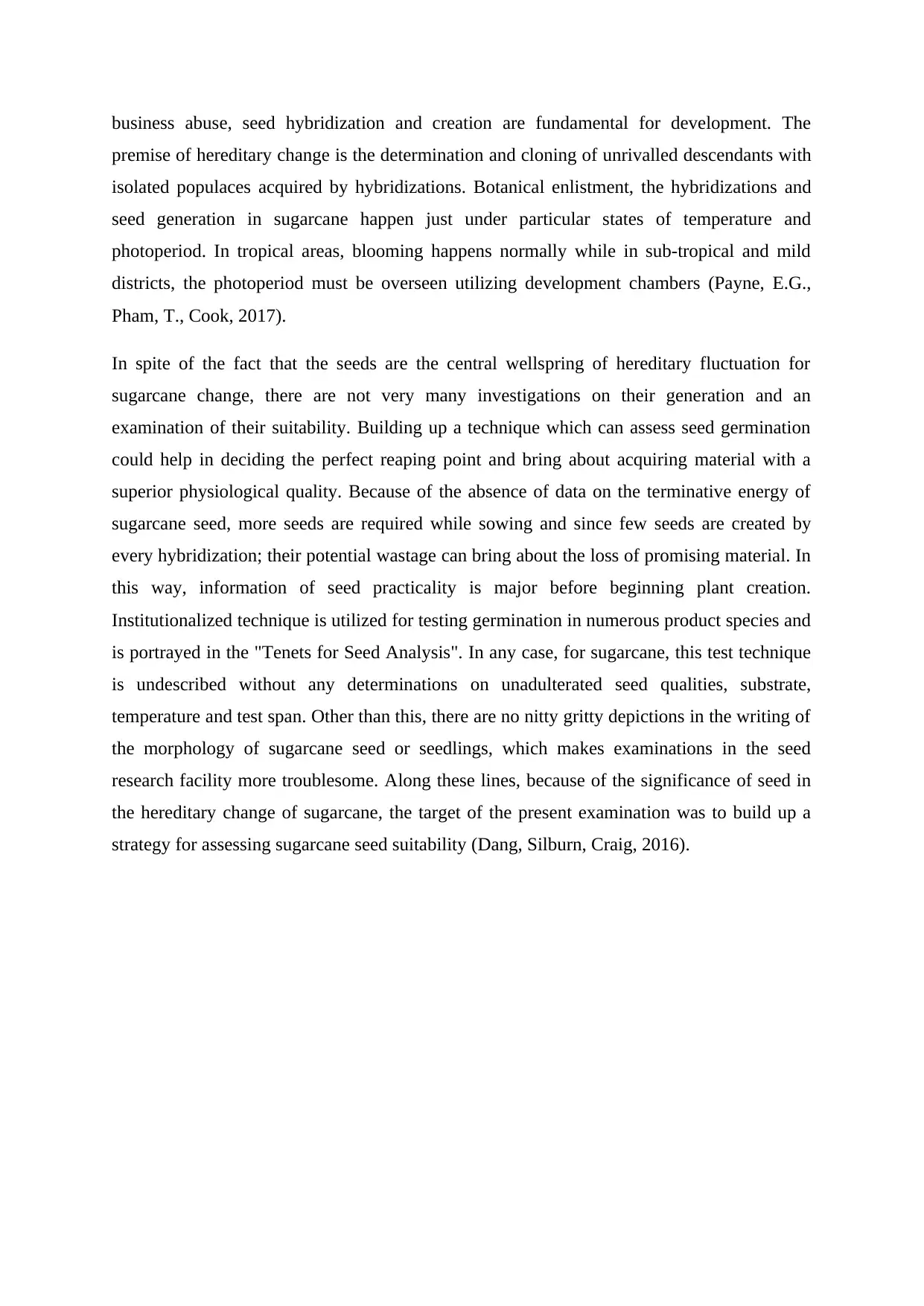
business abuse, seed hybridization and creation are fundamental for development. The
premise of hereditary change is the determination and cloning of unrivalled descendants with
isolated populaces acquired by hybridizations. Botanical enlistment, the hybridizations and
seed generation in sugarcane happen just under particular states of temperature and
photoperiod. In tropical areas, blooming happens normally while in sub-tropical and mild
districts, the photoperiod must be overseen utilizing development chambers (Payne, E.G.,
Pham, T., Cook, 2017).
In spite of the fact that the seeds are the central wellspring of hereditary fluctuation for
sugarcane change, there are not very many investigations on their generation and an
examination of their suitability. Building up a technique which can assess seed germination
could help in deciding the perfect reaping point and bring about acquiring material with a
superior physiological quality. Because of the absence of data on the terminative energy of
sugarcane seed, more seeds are required while sowing and since few seeds are created by
every hybridization; their potential wastage can bring about the loss of promising material. In
this way, information of seed practicality is major before beginning plant creation.
Institutionalized technique is utilized for testing germination in numerous product species and
is portrayed in the "Tenets for Seed Analysis". In any case, for sugarcane, this test technique
is undescribed without any determinations on unadulterated seed qualities, substrate,
temperature and test span. Other than this, there are no nitty gritty depictions in the writing of
the morphology of sugarcane seed or seedlings, which makes examinations in the seed
research facility more troublesome. Along these lines, because of the significance of seed in
the hereditary change of sugarcane, the target of the present examination was to build up a
strategy for assessing sugarcane seed suitability (Dang, Silburn, Craig, 2016).
premise of hereditary change is the determination and cloning of unrivalled descendants with
isolated populaces acquired by hybridizations. Botanical enlistment, the hybridizations and
seed generation in sugarcane happen just under particular states of temperature and
photoperiod. In tropical areas, blooming happens normally while in sub-tropical and mild
districts, the photoperiod must be overseen utilizing development chambers (Payne, E.G.,
Pham, T., Cook, 2017).
In spite of the fact that the seeds are the central wellspring of hereditary fluctuation for
sugarcane change, there are not very many investigations on their generation and an
examination of their suitability. Building up a technique which can assess seed germination
could help in deciding the perfect reaping point and bring about acquiring material with a
superior physiological quality. Because of the absence of data on the terminative energy of
sugarcane seed, more seeds are required while sowing and since few seeds are created by
every hybridization; their potential wastage can bring about the loss of promising material. In
this way, information of seed practicality is major before beginning plant creation.
Institutionalized technique is utilized for testing germination in numerous product species and
is portrayed in the "Tenets for Seed Analysis". In any case, for sugarcane, this test technique
is undescribed without any determinations on unadulterated seed qualities, substrate,
temperature and test span. Other than this, there are no nitty gritty depictions in the writing of
the morphology of sugarcane seed or seedlings, which makes examinations in the seed
research facility more troublesome. Along these lines, because of the significance of seed in
the hereditary change of sugarcane, the target of the present examination was to build up a
strategy for assessing sugarcane seed suitability (Dang, Silburn, Craig, 2016).
⊘ This is a preview!⊘
Do you want full access?
Subscribe today to unlock all pages.

Trusted by 1+ million students worldwide
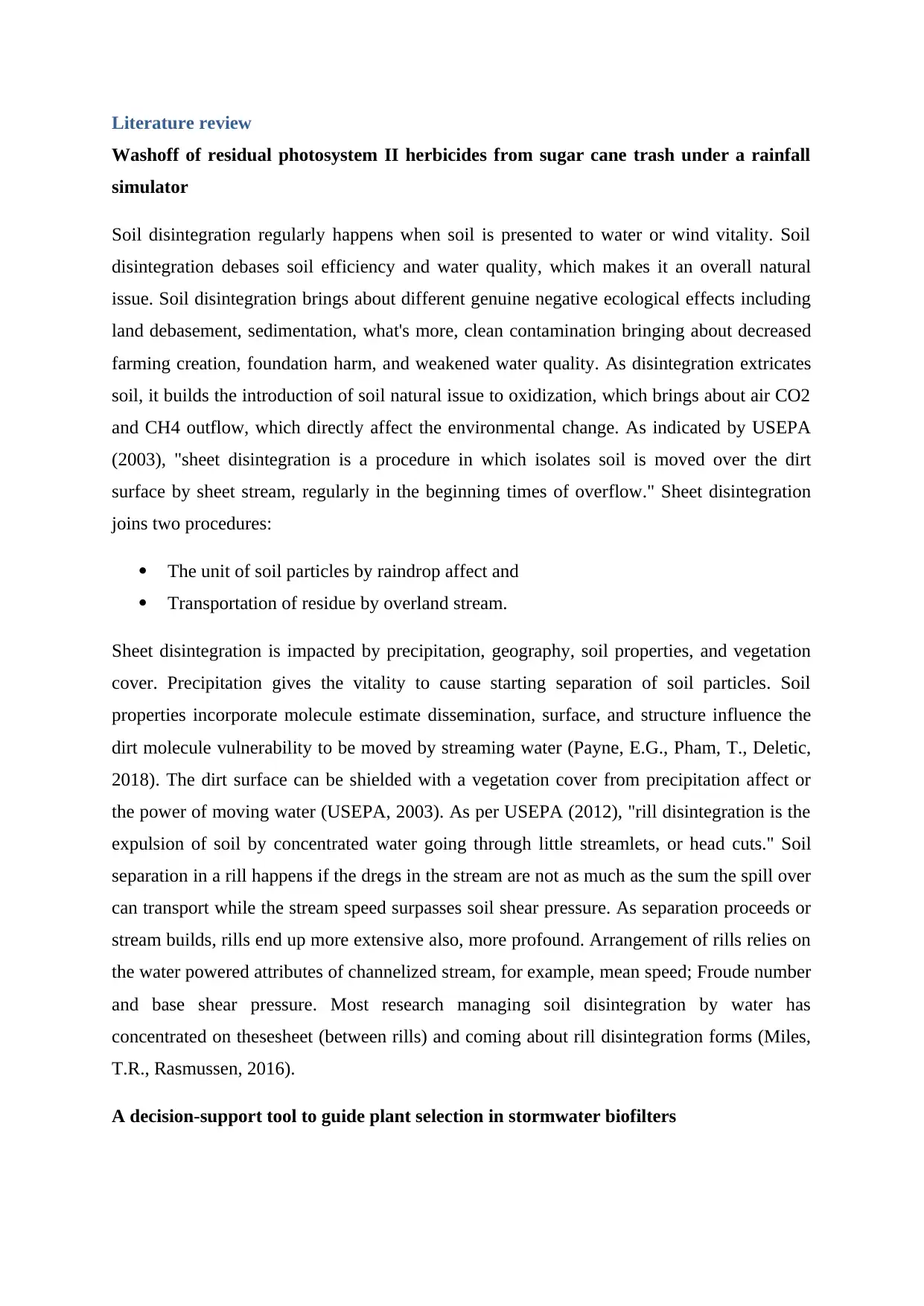
Literature review
Washoff of residual photosystem II herbicides from sugar cane trash under a rainfall
simulator
Soil disintegration regularly happens when soil is presented to water or wind vitality. Soil
disintegration debases soil efficiency and water quality, which makes it an overall natural
issue. Soil disintegration brings about different genuine negative ecological effects including
land debasement, sedimentation, what's more, clean contamination bringing about decreased
farming creation, foundation harm, and weakened water quality. As disintegration extricates
soil, it builds the introduction of soil natural issue to oxidization, which brings about air CO2
and CH4 outflow, which directly affect the environmental change. As indicated by USEPA
(2003), "sheet disintegration is a procedure in which isolates soil is moved over the dirt
surface by sheet stream, regularly in the beginning times of overflow." Sheet disintegration
joins two procedures:
The unit of soil particles by raindrop affect and
Transportation of residue by overland stream.
Sheet disintegration is impacted by precipitation, geography, soil properties, and vegetation
cover. Precipitation gives the vitality to cause starting separation of soil particles. Soil
properties incorporate molecule estimate dissemination, surface, and structure influence the
dirt molecule vulnerability to be moved by streaming water (Payne, E.G., Pham, T., Deletic,
2018). The dirt surface can be shielded with a vegetation cover from precipitation affect or
the power of moving water (USEPA, 2003). As per USEPA (2012), "rill disintegration is the
expulsion of soil by concentrated water going through little streamlets, or head cuts." Soil
separation in a rill happens if the dregs in the stream are not as much as the sum the spill over
can transport while the stream speed surpasses soil shear pressure. As separation proceeds or
stream builds, rills end up more extensive also, more profound. Arrangement of rills relies on
the water powered attributes of channelized stream, for example, mean speed; Froude number
and base shear pressure. Most research managing soil disintegration by water has
concentrated on thesesheet (between rills) and coming about rill disintegration forms (Miles,
T.R., Rasmussen, 2016).
A decision-support tool to guide plant selection in stormwater biofilters
Washoff of residual photosystem II herbicides from sugar cane trash under a rainfall
simulator
Soil disintegration regularly happens when soil is presented to water or wind vitality. Soil
disintegration debases soil efficiency and water quality, which makes it an overall natural
issue. Soil disintegration brings about different genuine negative ecological effects including
land debasement, sedimentation, what's more, clean contamination bringing about decreased
farming creation, foundation harm, and weakened water quality. As disintegration extricates
soil, it builds the introduction of soil natural issue to oxidization, which brings about air CO2
and CH4 outflow, which directly affect the environmental change. As indicated by USEPA
(2003), "sheet disintegration is a procedure in which isolates soil is moved over the dirt
surface by sheet stream, regularly in the beginning times of overflow." Sheet disintegration
joins two procedures:
The unit of soil particles by raindrop affect and
Transportation of residue by overland stream.
Sheet disintegration is impacted by precipitation, geography, soil properties, and vegetation
cover. Precipitation gives the vitality to cause starting separation of soil particles. Soil
properties incorporate molecule estimate dissemination, surface, and structure influence the
dirt molecule vulnerability to be moved by streaming water (Payne, E.G., Pham, T., Deletic,
2018). The dirt surface can be shielded with a vegetation cover from precipitation affect or
the power of moving water (USEPA, 2003). As per USEPA (2012), "rill disintegration is the
expulsion of soil by concentrated water going through little streamlets, or head cuts." Soil
separation in a rill happens if the dregs in the stream are not as much as the sum the spill over
can transport while the stream speed surpasses soil shear pressure. As separation proceeds or
stream builds, rills end up more extensive also, more profound. Arrangement of rills relies on
the water powered attributes of channelized stream, for example, mean speed; Froude number
and base shear pressure. Most research managing soil disintegration by water has
concentrated on thesesheet (between rills) and coming about rill disintegration forms (Miles,
T.R., Rasmussen, 2016).
A decision-support tool to guide plant selection in stormwater biofilters
Paraphrase This Document
Need a fresh take? Get an instant paraphrase of this document with our AI Paraphraser

As per USEPA, "ravine disintegration happens when channel advancement has advanced to
the point where the chasm is too wide and too profound to be in any way worked over." Gully
disintegration is a more dangerous type of rill disintegration. Lasting crevasses in farming
area are channels that are too profound to expel with common homestead culturing gear,
ordinarily running from 0.5 m (1.6 ft) to as much as 25 to 30 m (82-98 ft) profundity (Soil
Science Society of America, 2010) (Peng, J., Cao, Y., Rippy, 2016).
Aqueous contaminant removal and stormwater treatment using biochar
The effect of spill over toxins on water body quality relies upon both the current water quality
and the rate at which toxins enter the water body. At the point when water borne toxins, for
example, harmful metals travel a long separation, they may settle down and start affecting the
nearby condition. Certain chemicals in spill over have particular effects on water quality.
Over the top levels of supplements from farming overflow can cause green growth blossoms,
which obstructs the daylight and retain oxygen levels in the assortment of water. Add up to
suspended solids (TSS) in water builds turbidity, which specifically influences angle survival.
The estimation of water lucidity as the material suspended in water diminishes the section of
light through the water is known as turbidity. Overflow from farming area can convey
sickness causing living beings from fertilizer into adjacent water bodies and can make harm a
waterway what's more, neighbouring properties prompting the event of (transient) gorge
disintegration (Parker, E.A., Rippy, M.A., Mehring, 2016).
Analysts have underlined the impacts of overwhelming metal gathering in silt what's more, in
water as far as hazard appraisal. Due to biogeochemical forms and natural states of
waterways, silt goes about as an imperative sink for substantial metals and other non-point
source contaminations influencing water quality. Substantial metals have a tendency to amass
in the surface silt and can cause wellbeing perils when fixations achieve least limit. Surface
overflow conveys overwhelming metals, supplements, and dregs into surface water, which
brings about the decay of water quality and executing of amphibian species. In the US,
95,770 km of waterways and streams were debilitated or disabled by storm water overflow
(Shor, A., Doyle, J., Farrell, 2017).
Devices, systems and methods for controlling erosion. U.S. Patent 8,821,076
In 1948, the Federal Water Pollution Control Act was the main government law ensuring
water contamination. This demonstration was altered in 1972 because of developing
the point where the chasm is too wide and too profound to be in any way worked over." Gully
disintegration is a more dangerous type of rill disintegration. Lasting crevasses in farming
area are channels that are too profound to expel with common homestead culturing gear,
ordinarily running from 0.5 m (1.6 ft) to as much as 25 to 30 m (82-98 ft) profundity (Soil
Science Society of America, 2010) (Peng, J., Cao, Y., Rippy, 2016).
Aqueous contaminant removal and stormwater treatment using biochar
The effect of spill over toxins on water body quality relies upon both the current water quality
and the rate at which toxins enter the water body. At the point when water borne toxins, for
example, harmful metals travel a long separation, they may settle down and start affecting the
nearby condition. Certain chemicals in spill over have particular effects on water quality.
Over the top levels of supplements from farming overflow can cause green growth blossoms,
which obstructs the daylight and retain oxygen levels in the assortment of water. Add up to
suspended solids (TSS) in water builds turbidity, which specifically influences angle survival.
The estimation of water lucidity as the material suspended in water diminishes the section of
light through the water is known as turbidity. Overflow from farming area can convey
sickness causing living beings from fertilizer into adjacent water bodies and can make harm a
waterway what's more, neighbouring properties prompting the event of (transient) gorge
disintegration (Parker, E.A., Rippy, M.A., Mehring, 2016).
Analysts have underlined the impacts of overwhelming metal gathering in silt what's more, in
water as far as hazard appraisal. Due to biogeochemical forms and natural states of
waterways, silt goes about as an imperative sink for substantial metals and other non-point
source contaminations influencing water quality. Substantial metals have a tendency to amass
in the surface silt and can cause wellbeing perils when fixations achieve least limit. Surface
overflow conveys overwhelming metals, supplements, and dregs into surface water, which
brings about the decay of water quality and executing of amphibian species. In the US,
95,770 km of waterways and streams were debilitated or disabled by storm water overflow
(Shor, A., Doyle, J., Farrell, 2017).
Devices, systems and methods for controlling erosion. U.S. Patent 8,821,076
In 1948, the Federal Water Pollution Control Act was the main government law ensuring
water contamination. This demonstration was altered in 1972 because of developing
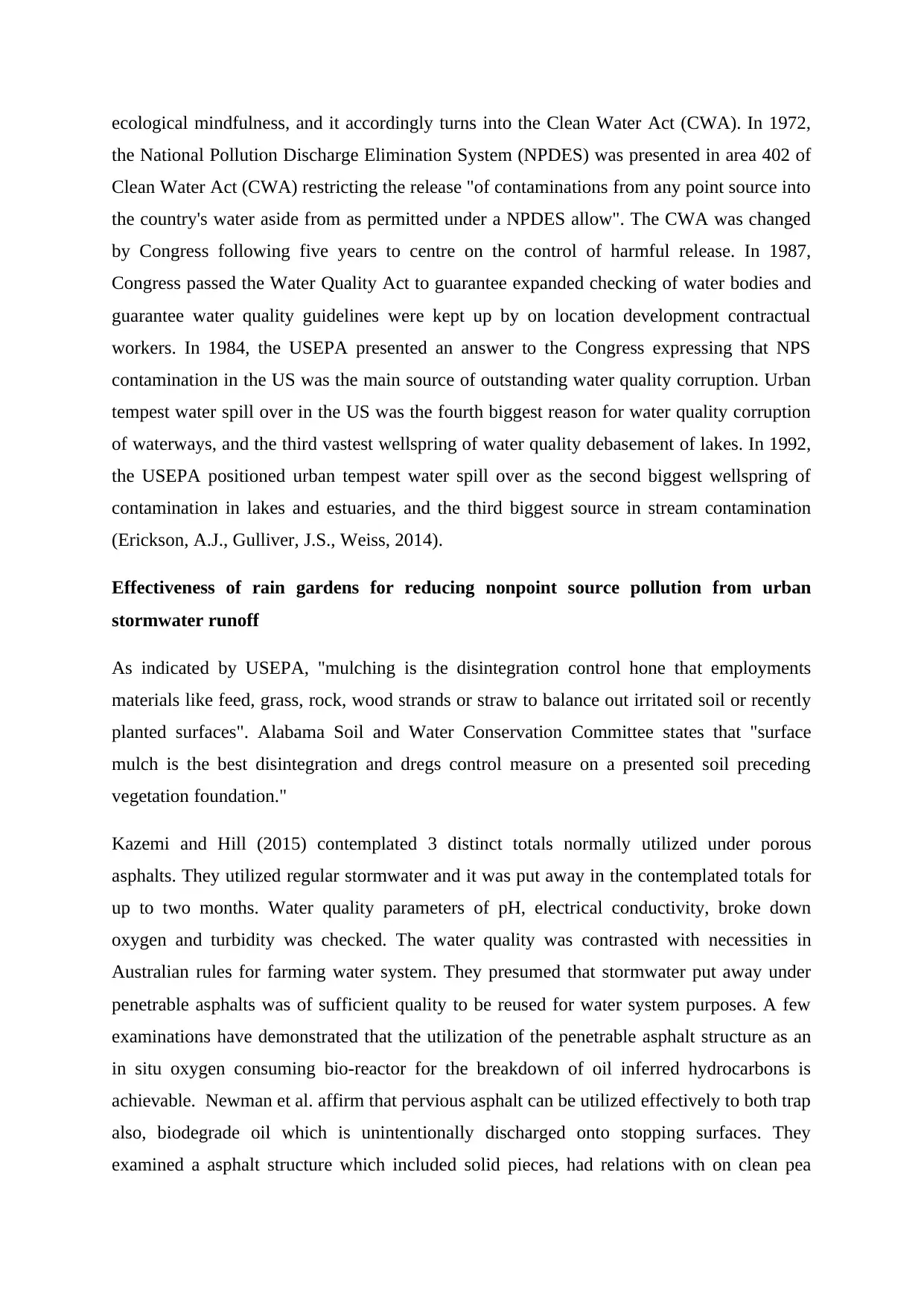
ecological mindfulness, and it accordingly turns into the Clean Water Act (CWA). In 1972,
the National Pollution Discharge Elimination System (NPDES) was presented in area 402 of
Clean Water Act (CWA) restricting the release "of contaminations from any point source into
the country's water aside from as permitted under a NPDES allow". The CWA was changed
by Congress following five years to centre on the control of harmful release. In 1987,
Congress passed the Water Quality Act to guarantee expanded checking of water bodies and
guarantee water quality guidelines were kept up by on location development contractual
workers. In 1984, the USEPA presented an answer to the Congress expressing that NPS
contamination in the US was the main source of outstanding water quality corruption. Urban
tempest water spill over in the US was the fourth biggest reason for water quality corruption
of waterways, and the third vastest wellspring of water quality debasement of lakes. In 1992,
the USEPA positioned urban tempest water spill over as the second biggest wellspring of
contamination in lakes and estuaries, and the third biggest source in stream contamination
(Erickson, A.J., Gulliver, J.S., Weiss, 2014).
Effectiveness of rain gardens for reducing nonpoint source pollution from urban
stormwater runoff
As indicated by USEPA, "mulching is the disintegration control hone that employments
materials like feed, grass, rock, wood strands or straw to balance out irritated soil or recently
planted surfaces". Alabama Soil and Water Conservation Committee states that "surface
mulch is the best disintegration and dregs control measure on a presented soil preceding
vegetation foundation."
Kazemi and Hill (2015) contemplated 3 distinct totals normally utilized under porous
asphalts. They utilized regular stormwater and it was put away in the contemplated totals for
up to two months. Water quality parameters of pH, electrical conductivity, broke down
oxygen and turbidity was checked. The water quality was contrasted with necessities in
Australian rules for farming water system. They presumed that stormwater put away under
penetrable asphalts was of sufficient quality to be reused for water system purposes. A few
examinations have demonstrated that the utilization of the penetrable asphalt structure as an
in situ oxygen consuming bio-reactor for the breakdown of oil inferred hydrocarbons is
achievable. Newman et al. affirm that pervious asphalt can be utilized effectively to both trap
also, biodegrade oil which is unintentionally discharged onto stopping surfaces. They
examined a asphalt structure which included solid pieces, had relations with on clean pea
the National Pollution Discharge Elimination System (NPDES) was presented in area 402 of
Clean Water Act (CWA) restricting the release "of contaminations from any point source into
the country's water aside from as permitted under a NPDES allow". The CWA was changed
by Congress following five years to centre on the control of harmful release. In 1987,
Congress passed the Water Quality Act to guarantee expanded checking of water bodies and
guarantee water quality guidelines were kept up by on location development contractual
workers. In 1984, the USEPA presented an answer to the Congress expressing that NPS
contamination in the US was the main source of outstanding water quality corruption. Urban
tempest water spill over in the US was the fourth biggest reason for water quality corruption
of waterways, and the third vastest wellspring of water quality debasement of lakes. In 1992,
the USEPA positioned urban tempest water spill over as the second biggest wellspring of
contamination in lakes and estuaries, and the third biggest source in stream contamination
(Erickson, A.J., Gulliver, J.S., Weiss, 2014).
Effectiveness of rain gardens for reducing nonpoint source pollution from urban
stormwater runoff
As indicated by USEPA, "mulching is the disintegration control hone that employments
materials like feed, grass, rock, wood strands or straw to balance out irritated soil or recently
planted surfaces". Alabama Soil and Water Conservation Committee states that "surface
mulch is the best disintegration and dregs control measure on a presented soil preceding
vegetation foundation."
Kazemi and Hill (2015) contemplated 3 distinct totals normally utilized under porous
asphalts. They utilized regular stormwater and it was put away in the contemplated totals for
up to two months. Water quality parameters of pH, electrical conductivity, broke down
oxygen and turbidity was checked. The water quality was contrasted with necessities in
Australian rules for farming water system. They presumed that stormwater put away under
penetrable asphalts was of sufficient quality to be reused for water system purposes. A few
examinations have demonstrated that the utilization of the penetrable asphalt structure as an
in situ oxygen consuming bio-reactor for the breakdown of oil inferred hydrocarbons is
achievable. Newman et al. affirm that pervious asphalt can be utilized effectively to both trap
also, biodegrade oil which is unintentionally discharged onto stopping surfaces. They
examined a asphalt structure which included solid pieces, had relations with on clean pea
⊘ This is a preview!⊘
Do you want full access?
Subscribe today to unlock all pages.

Trusted by 1+ million students worldwide
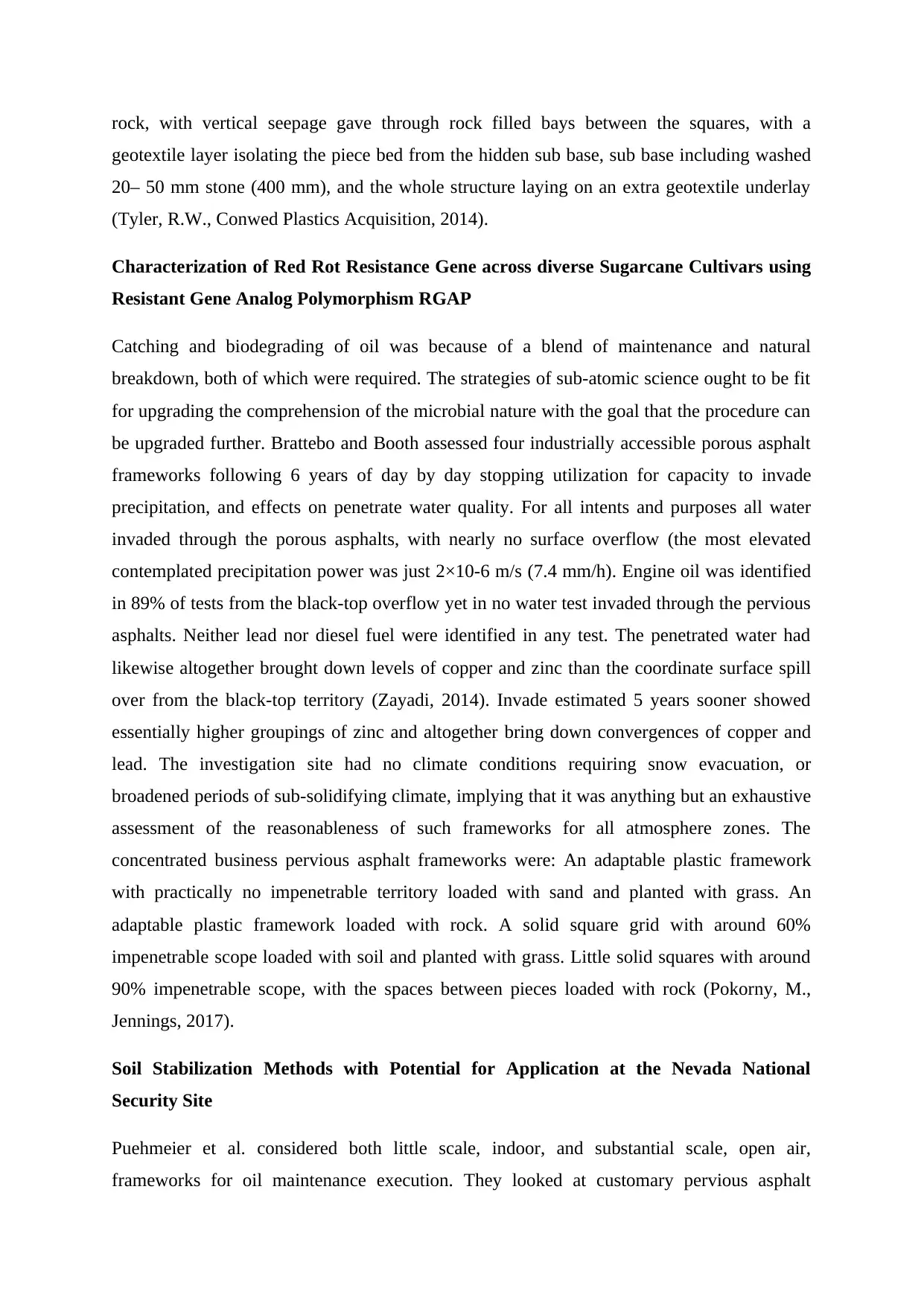
rock, with vertical seepage gave through rock filled bays between the squares, with a
geotextile layer isolating the piece bed from the hidden sub base, sub base including washed
20– 50 mm stone (400 mm), and the whole structure laying on an extra geotextile underlay
(Tyler, R.W., Conwed Plastics Acquisition, 2014).
Characterization of Red Rot Resistance Gene across diverse Sugarcane Cultivars using
Resistant Gene Analog Polymorphism RGAP
Catching and biodegrading of oil was because of a blend of maintenance and natural
breakdown, both of which were required. The strategies of sub-atomic science ought to be fit
for upgrading the comprehension of the microbial nature with the goal that the procedure can
be upgraded further. Brattebo and Booth assessed four industrially accessible porous asphalt
frameworks following 6 years of day by day stopping utilization for capacity to invade
precipitation, and effects on penetrate water quality. For all intents and purposes all water
invaded through the porous asphalts, with nearly no surface overflow (the most elevated
contemplated precipitation power was just 2×10-6 m/s (7.4 mm/h). Engine oil was identified
in 89% of tests from the black-top overflow yet in no water test invaded through the pervious
asphalts. Neither lead nor diesel fuel were identified in any test. The penetrated water had
likewise altogether brought down levels of copper and zinc than the coordinate surface spill
over from the black-top territory (Zayadi, 2014). Invade estimated 5 years sooner showed
essentially higher groupings of zinc and altogether bring down convergences of copper and
lead. The investigation site had no climate conditions requiring snow evacuation, or
broadened periods of sub-solidifying climate, implying that it was anything but an exhaustive
assessment of the reasonableness of such frameworks for all atmosphere zones. The
concentrated business pervious asphalt frameworks were: An adaptable plastic framework
with practically no impenetrable territory loaded with sand and planted with grass. An
adaptable plastic framework loaded with rock. A solid square grid with around 60%
impenetrable scope loaded with soil and planted with grass. Little solid squares with around
90% impenetrable scope, with the spaces between pieces loaded with rock (Pokorny, M.,
Jennings, 2017).
Soil Stabilization Methods with Potential for Application at the Nevada National
Security Site
Puehmeier et al. considered both little scale, indoor, and substantial scale, open air,
frameworks for oil maintenance execution. They looked at customary pervious asphalt
geotextile layer isolating the piece bed from the hidden sub base, sub base including washed
20– 50 mm stone (400 mm), and the whole structure laying on an extra geotextile underlay
(Tyler, R.W., Conwed Plastics Acquisition, 2014).
Characterization of Red Rot Resistance Gene across diverse Sugarcane Cultivars using
Resistant Gene Analog Polymorphism RGAP
Catching and biodegrading of oil was because of a blend of maintenance and natural
breakdown, both of which were required. The strategies of sub-atomic science ought to be fit
for upgrading the comprehension of the microbial nature with the goal that the procedure can
be upgraded further. Brattebo and Booth assessed four industrially accessible porous asphalt
frameworks following 6 years of day by day stopping utilization for capacity to invade
precipitation, and effects on penetrate water quality. For all intents and purposes all water
invaded through the porous asphalts, with nearly no surface overflow (the most elevated
contemplated precipitation power was just 2×10-6 m/s (7.4 mm/h). Engine oil was identified
in 89% of tests from the black-top overflow yet in no water test invaded through the pervious
asphalts. Neither lead nor diesel fuel were identified in any test. The penetrated water had
likewise altogether brought down levels of copper and zinc than the coordinate surface spill
over from the black-top territory (Zayadi, 2014). Invade estimated 5 years sooner showed
essentially higher groupings of zinc and altogether bring down convergences of copper and
lead. The investigation site had no climate conditions requiring snow evacuation, or
broadened periods of sub-solidifying climate, implying that it was anything but an exhaustive
assessment of the reasonableness of such frameworks for all atmosphere zones. The
concentrated business pervious asphalt frameworks were: An adaptable plastic framework
with practically no impenetrable territory loaded with sand and planted with grass. An
adaptable plastic framework loaded with rock. A solid square grid with around 60%
impenetrable scope loaded with soil and planted with grass. Little solid squares with around
90% impenetrable scope, with the spaces between pieces loaded with rock (Pokorny, M.,
Jennings, 2017).
Soil Stabilization Methods with Potential for Application at the Nevada National
Security Site
Puehmeier et al. considered both little scale, indoor, and substantial scale, open air,
frameworks for oil maintenance execution. They looked at customary pervious asphalt
Paraphrase This Document
Need a fresh take? Get an instant paraphrase of this document with our AI Paraphraser
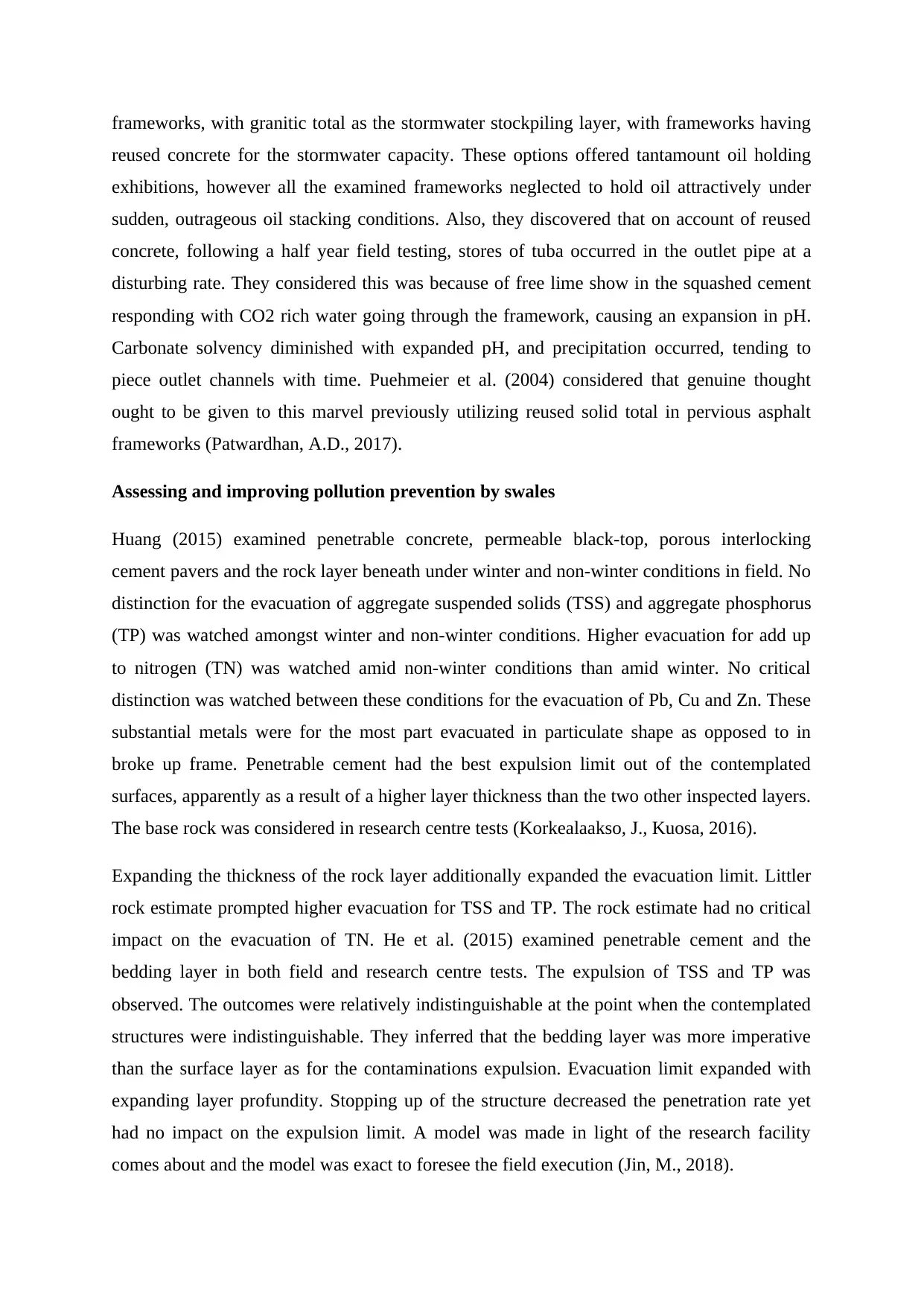
frameworks, with granitic total as the stormwater stockpiling layer, with frameworks having
reused concrete for the stormwater capacity. These options offered tantamount oil holding
exhibitions, however all the examined frameworks neglected to hold oil attractively under
sudden, outrageous oil stacking conditions. Also, they discovered that on account of reused
concrete, following a half year field testing, stores of tuba occurred in the outlet pipe at a
disturbing rate. They considered this was because of free lime show in the squashed cement
responding with CO2 rich water going through the framework, causing an expansion in pH.
Carbonate solvency diminished with expanded pH, and precipitation occurred, tending to
piece outlet channels with time. Puehmeier et al. (2004) considered that genuine thought
ought to be given to this marvel previously utilizing reused solid total in pervious asphalt
frameworks (Patwardhan, A.D., 2017).
Assessing and improving pollution prevention by swales
Huang (2015) examined penetrable concrete, permeable black-top, porous interlocking
cement pavers and the rock layer beneath under winter and non-winter conditions in field. No
distinction for the evacuation of aggregate suspended solids (TSS) and aggregate phosphorus
(TP) was watched amongst winter and non-winter conditions. Higher evacuation for add up
to nitrogen (TN) was watched amid non-winter conditions than amid winter. No critical
distinction was watched between these conditions for the evacuation of Pb, Cu and Zn. These
substantial metals were for the most part evacuated in particulate shape as opposed to in
broke up frame. Penetrable cement had the best expulsion limit out of the contemplated
surfaces, apparently as a result of a higher layer thickness than the two other inspected layers.
The base rock was considered in research centre tests (Korkealaakso, J., Kuosa, 2016).
Expanding the thickness of the rock layer additionally expanded the evacuation limit. Littler
rock estimate prompted higher evacuation for TSS and TP. The rock estimate had no critical
impact on the evacuation of TN. He et al. (2015) examined penetrable cement and the
bedding layer in both field and research centre tests. The expulsion of TSS and TP was
observed. The outcomes were relatively indistinguishable at the point when the contemplated
structures were indistinguishable. They inferred that the bedding layer was more imperative
than the surface layer as for the contaminations expulsion. Evacuation limit expanded with
expanding layer profundity. Stopping up of the structure decreased the penetration rate yet
had no impact on the expulsion limit. A model was made in light of the research facility
comes about and the model was exact to foresee the field execution (Jin, M., 2018).
reused concrete for the stormwater capacity. These options offered tantamount oil holding
exhibitions, however all the examined frameworks neglected to hold oil attractively under
sudden, outrageous oil stacking conditions. Also, they discovered that on account of reused
concrete, following a half year field testing, stores of tuba occurred in the outlet pipe at a
disturbing rate. They considered this was because of free lime show in the squashed cement
responding with CO2 rich water going through the framework, causing an expansion in pH.
Carbonate solvency diminished with expanded pH, and precipitation occurred, tending to
piece outlet channels with time. Puehmeier et al. (2004) considered that genuine thought
ought to be given to this marvel previously utilizing reused solid total in pervious asphalt
frameworks (Patwardhan, A.D., 2017).
Assessing and improving pollution prevention by swales
Huang (2015) examined penetrable concrete, permeable black-top, porous interlocking
cement pavers and the rock layer beneath under winter and non-winter conditions in field. No
distinction for the evacuation of aggregate suspended solids (TSS) and aggregate phosphorus
(TP) was watched amongst winter and non-winter conditions. Higher evacuation for add up
to nitrogen (TN) was watched amid non-winter conditions than amid winter. No critical
distinction was watched between these conditions for the evacuation of Pb, Cu and Zn. These
substantial metals were for the most part evacuated in particulate shape as opposed to in
broke up frame. Penetrable cement had the best expulsion limit out of the contemplated
surfaces, apparently as a result of a higher layer thickness than the two other inspected layers.
The base rock was considered in research centre tests (Korkealaakso, J., Kuosa, 2016).
Expanding the thickness of the rock layer additionally expanded the evacuation limit. Littler
rock estimate prompted higher evacuation for TSS and TP. The rock estimate had no critical
impact on the evacuation of TN. He et al. (2015) examined penetrable cement and the
bedding layer in both field and research centre tests. The expulsion of TSS and TP was
observed. The outcomes were relatively indistinguishable at the point when the contemplated
structures were indistinguishable. They inferred that the bedding layer was more imperative
than the surface layer as for the contaminations expulsion. Evacuation limit expanded with
expanding layer profundity. Stopping up of the structure decreased the penetration rate yet
had no impact on the expulsion limit. A model was made in light of the research facility
comes about and the model was exact to foresee the field execution (Jin, M., 2018).
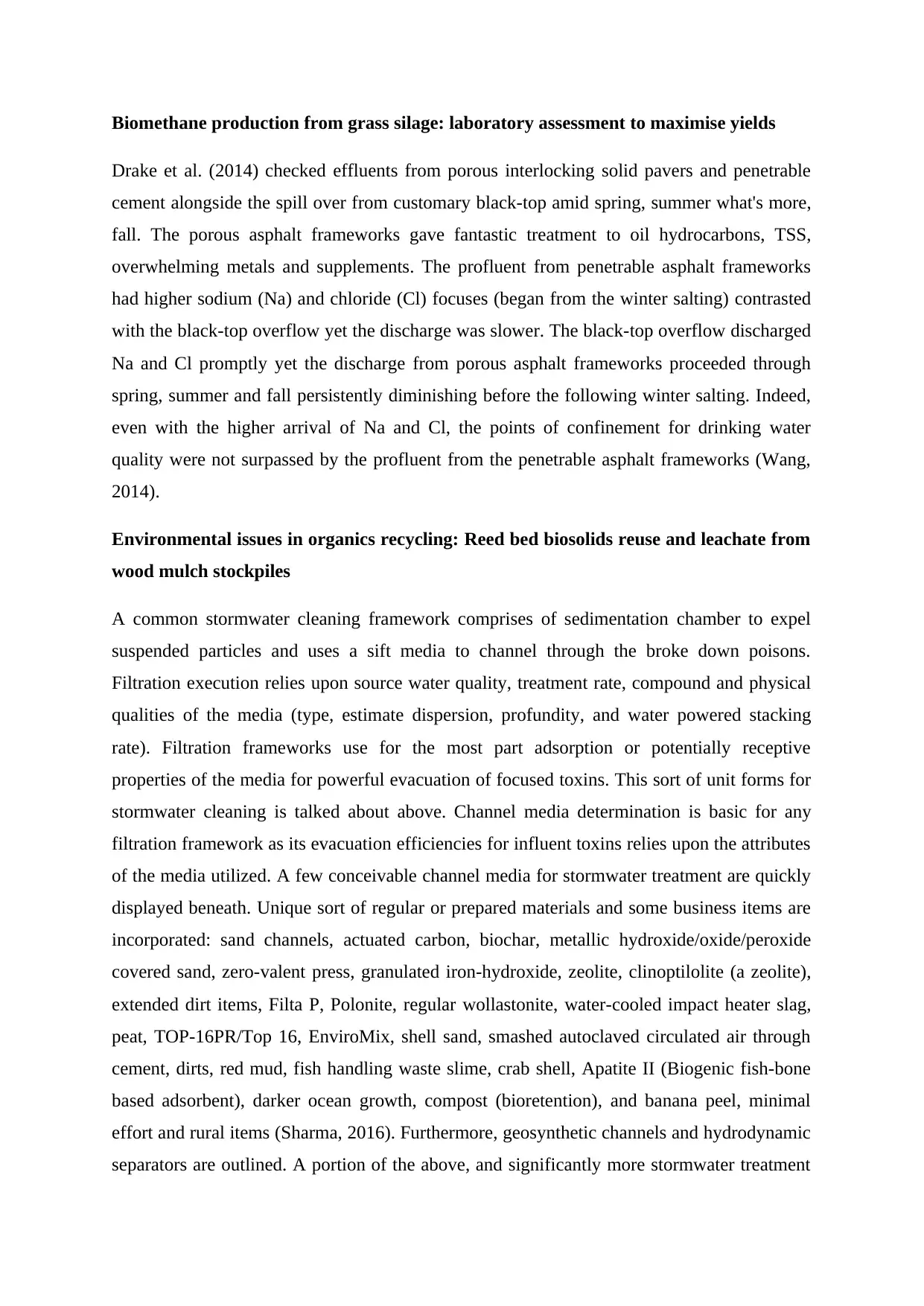
Biomethane production from grass silage: laboratory assessment to maximise yields
Drake et al. (2014) checked effluents from porous interlocking solid pavers and penetrable
cement alongside the spill over from customary black-top amid spring, summer what's more,
fall. The porous asphalt frameworks gave fantastic treatment to oil hydrocarbons, TSS,
overwhelming metals and supplements. The profluent from penetrable asphalt frameworks
had higher sodium (Na) and chloride (Cl) focuses (began from the winter salting) contrasted
with the black-top overflow yet the discharge was slower. The black-top overflow discharged
Na and Cl promptly yet the discharge from porous asphalt frameworks proceeded through
spring, summer and fall persistently diminishing before the following winter salting. Indeed,
even with the higher arrival of Na and Cl, the points of confinement for drinking water
quality were not surpassed by the profluent from the penetrable asphalt frameworks (Wang,
2014).
Environmental issues in organics recycling: Reed bed biosolids reuse and leachate from
wood mulch stockpiles
A common stormwater cleaning framework comprises of sedimentation chamber to expel
suspended particles and uses a sift media to channel through the broke down poisons.
Filtration execution relies upon source water quality, treatment rate, compound and physical
qualities of the media (type, estimate dispersion, profundity, and water powered stacking
rate). Filtration frameworks use for the most part adsorption or potentially receptive
properties of the media for powerful evacuation of focused toxins. This sort of unit forms for
stormwater cleaning is talked about above. Channel media determination is basic for any
filtration framework as its evacuation efficiencies for influent toxins relies upon the attributes
of the media utilized. A few conceivable channel media for stormwater treatment are quickly
displayed beneath. Unique sort of regular or prepared materials and some business items are
incorporated: sand channels, actuated carbon, biochar, metallic hydroxide/oxide/peroxide
covered sand, zero-valent press, granulated iron-hydroxide, zeolite, clinoptilolite (a zeolite),
extended dirt items, Filta P, Polonite, regular wollastonite, water-cooled impact heater slag,
peat, TOP-16PR/Top 16, EnviroMix, shell sand, smashed autoclaved circulated air through
cement, dirts, red mud, fish handling waste slime, crab shell, Apatite II (Biogenic fish-bone
based adsorbent), darker ocean growth, compost (bioretention), and banana peel, minimal
effort and rural items (Sharma, 2016). Furthermore, geosynthetic channels and hydrodynamic
separators are outlined. A portion of the above, and significantly more stormwater treatment
Drake et al. (2014) checked effluents from porous interlocking solid pavers and penetrable
cement alongside the spill over from customary black-top amid spring, summer what's more,
fall. The porous asphalt frameworks gave fantastic treatment to oil hydrocarbons, TSS,
overwhelming metals and supplements. The profluent from penetrable asphalt frameworks
had higher sodium (Na) and chloride (Cl) focuses (began from the winter salting) contrasted
with the black-top overflow yet the discharge was slower. The black-top overflow discharged
Na and Cl promptly yet the discharge from porous asphalt frameworks proceeded through
spring, summer and fall persistently diminishing before the following winter salting. Indeed,
even with the higher arrival of Na and Cl, the points of confinement for drinking water
quality were not surpassed by the profluent from the penetrable asphalt frameworks (Wang,
2014).
Environmental issues in organics recycling: Reed bed biosolids reuse and leachate from
wood mulch stockpiles
A common stormwater cleaning framework comprises of sedimentation chamber to expel
suspended particles and uses a sift media to channel through the broke down poisons.
Filtration execution relies upon source water quality, treatment rate, compound and physical
qualities of the media (type, estimate dispersion, profundity, and water powered stacking
rate). Filtration frameworks use for the most part adsorption or potentially receptive
properties of the media for powerful evacuation of focused toxins. This sort of unit forms for
stormwater cleaning is talked about above. Channel media determination is basic for any
filtration framework as its evacuation efficiencies for influent toxins relies upon the attributes
of the media utilized. A few conceivable channel media for stormwater treatment are quickly
displayed beneath. Unique sort of regular or prepared materials and some business items are
incorporated: sand channels, actuated carbon, biochar, metallic hydroxide/oxide/peroxide
covered sand, zero-valent press, granulated iron-hydroxide, zeolite, clinoptilolite (a zeolite),
extended dirt items, Filta P, Polonite, regular wollastonite, water-cooled impact heater slag,
peat, TOP-16PR/Top 16, EnviroMix, shell sand, smashed autoclaved circulated air through
cement, dirts, red mud, fish handling waste slime, crab shell, Apatite II (Biogenic fish-bone
based adsorbent), darker ocean growth, compost (bioretention), and banana peel, minimal
effort and rural items (Sharma, 2016). Furthermore, geosynthetic channels and hydrodynamic
separators are outlined. A portion of the above, and significantly more stormwater treatment
⊘ This is a preview!⊘
Do you want full access?
Subscribe today to unlock all pages.

Trusted by 1+ million students worldwide
1 out of 24
Your All-in-One AI-Powered Toolkit for Academic Success.
+13062052269
info@desklib.com
Available 24*7 on WhatsApp / Email
![[object Object]](/_next/static/media/star-bottom.7253800d.svg)
Unlock your academic potential
Copyright © 2020–2026 A2Z Services. All Rights Reserved. Developed and managed by ZUCOL.
